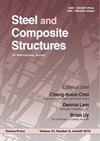Effective width of steel-concrete composite beams under negative moments in service stages
IF 4
3区 工程技术
Q1 CONSTRUCTION & BUILDING TECHNOLOGY
引用次数: 0
Abstract
The effective flange width was usually introduced into elementary beam theory to consider the shear lag effect in steel-concrete composite beams. Previous studies have primarily focused on the effective width under positive moments and elastic loading, whereas it is still not clear for negative moment cases in the normal service stages. To account for this problem, this paper proposed simplified formulas for the effective flange width and reinforcement stress of composite beams under negative moments in service stages. First, a 10-degree-of-freedom (DOF) fiber beam element considering the shear lag effect and interfacial slip effect was proposed, and a computational procedure was developed in the OpenSees software. The accuracy and applicability of the proposed model were verified through comparisons with experimental results. Second, a method was proposed for determining the effective width of composite beams under negative moments based on reinforcement stress. Employing the proposed model, the simplified formulas were proposed via numerical fitting for cases under uniform loading and centralized loading at the mid-span. Finally, based on the proposed formulas, a simplified calculation method for the reinforcement stress in service stages was established. Comparisons were made between the proposed formulas and design code. The results showed that the design code method greatly underestimated the contribution of concrete under negative moments, leading to notable overestimations in the reinforcement stress and crack width.服役阶段负弯矩作用下钢-混凝土组合梁有效宽度
为了考虑钢-混凝土组合梁的剪力滞效应,通常在基本梁理论中引入有效翼缘宽度。以往的研究主要集中在正弯矩和弹性荷载作用下的有效宽度,而在正常使用阶段的负弯矩情况下的有效宽度尚不清楚。针对这一问题,提出了组合梁在服役阶段负弯矩作用下的有效翼缘宽度和配筋应力的简化计算公式。首先,提出了一种考虑剪切滞后效应和界面滑移效应的10自由度光纤梁单元,并在OpenSees软件中开发了计算程序。通过与实验结果的比较,验证了所提模型的准确性和适用性。其次,提出了一种基于配筋应力确定负弯矩作用下组合梁有效宽度的方法。利用该模型,通过数值拟合,给出了跨中均布荷载和集中荷载情况下的简化公式。最后,在此基础上,建立了服役阶段钢筋应力的简化计算方法。将提出的公式与设计规范进行了比较。结果表明,设计规范方法大大低估了负弯矩作用下混凝土的贡献,导致钢筋应力和裂缝宽度的估计明显过高。
本文章由计算机程序翻译,如有差异,请以英文原文为准。
求助全文
约1分钟内获得全文
求助全文
来源期刊

Steel and Composite Structures
工程技术-材料科学:复合
CiteScore
8.50
自引率
19.60%
发文量
0
审稿时长
7.5 months
期刊介绍:
Steel & Composite Structures, An International Journal, provides and excellent publication channel which reports the up-to-date research developments in the steel structures and steel-concrete composite structures, and FRP plated structures from the international steel community. The research results reported in this journal address all the aspects of theoretical and experimental research, including Buckling/Stability, Fatigue/Fracture, Fire Performance, Connections, Frames/Bridges, Plates/Shells, Composite Structural Components, Hybrid Structures, Fabrication/Maintenance, Design Codes, Dynamics/Vibrations, Nonferrous Metal Structures, Non-metalic plates, Analytical Methods.
The Journal specially wishes to bridge the gap between the theoretical developments and practical applications for the benefits of both academic researchers and practicing engineers. In this light, contributions from the practicing engineers are especially welcome.
 求助内容:
求助内容: 应助结果提醒方式:
应助结果提醒方式:


